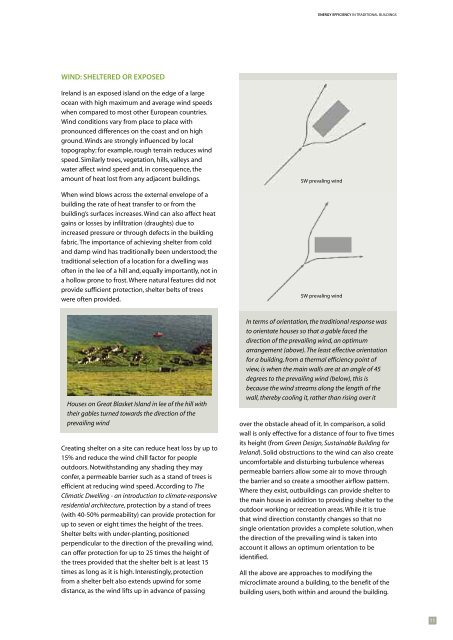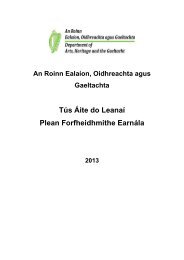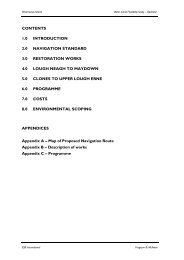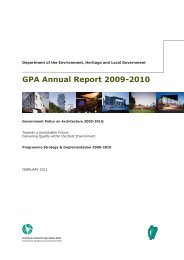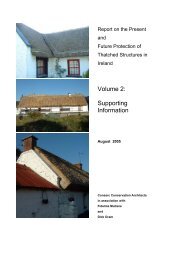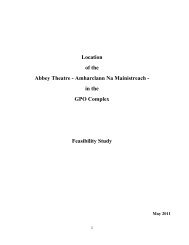Energy Efficiency in Traditional Buildings - Dublin City Council
Energy Efficiency in Traditional Buildings - Dublin City Council
Energy Efficiency in Traditional Buildings - Dublin City Council
You also want an ePaper? Increase the reach of your titles
YUMPU automatically turns print PDFs into web optimized ePapers that Google loves.
ENERGY EFFICIENCY IN TRADITIONAL BUILDINGS<br />
WIND: SHELTERED OR EXPOSED<br />
Ireland is an exposed island on the edge of a large<br />
ocean with high maximum and average w<strong>in</strong>d speeds<br />
when compared to most other European countries.<br />
W<strong>in</strong>d conditions vary from place to place with<br />
pronounced differences on the coast and on high<br />
ground. W<strong>in</strong>ds are strongly <strong>in</strong>fluenced by local<br />
topography: for example, rough terra<strong>in</strong> reduces w<strong>in</strong>d<br />
speed. Similarly trees, vegetation, hills, valleys and<br />
water affect w<strong>in</strong>d speed and, <strong>in</strong> consequence, the<br />
amount of heat lost from any adjacent build<strong>in</strong>gs.<br />
When w<strong>in</strong>d blows across the external envelope of a<br />
build<strong>in</strong>g the rate of heat transfer to or from the<br />
build<strong>in</strong>g’s surfaces <strong>in</strong>creases. W<strong>in</strong>d can also affect heat<br />
ga<strong>in</strong>s or losses by <strong>in</strong>filtration (draughts) due to<br />
<strong>in</strong>creased pressure or through defects <strong>in</strong> the build<strong>in</strong>g<br />
fabric. The importance of achiev<strong>in</strong>g shelter from cold<br />
and damp w<strong>in</strong>d has traditionally been understood; the<br />
traditional selection of a location for a dwell<strong>in</strong>g was<br />
often <strong>in</strong> the lee of a hill and, equally importantly, not <strong>in</strong><br />
a hollow prone to frost. Where natural features did not<br />
provide sufficient protection, shelter belts of trees<br />
were often provided.<br />
SW preval<strong>in</strong>g w<strong>in</strong>d<br />
SW preval<strong>in</strong>g w<strong>in</strong>d<br />
Houses on Great Blasket Island <strong>in</strong> lee of the hill with<br />
their gables turned towards the direction of the<br />
prevail<strong>in</strong>g w<strong>in</strong>d<br />
Creat<strong>in</strong>g shelter on a site can reduce heat loss by up to<br />
15% and reduce the w<strong>in</strong>d chill factor for people<br />
outdoors. Notwithstand<strong>in</strong>g any shad<strong>in</strong>g they may<br />
confer, a permeable barrier such as a stand of trees is<br />
efficient at reduc<strong>in</strong>g w<strong>in</strong>d speed. Accord<strong>in</strong>g to The<br />
Climatic Dwell<strong>in</strong>g - an <strong>in</strong>troduction to climate-responsive<br />
residential architecture, protection by a stand of trees<br />
(with 40-50% permeability) can provide protection for<br />
up to seven or eight times the height of the trees.<br />
Shelter belts with under-plant<strong>in</strong>g, positioned<br />
perpendicular to the direction of the prevail<strong>in</strong>g w<strong>in</strong>d,<br />
can offer protection for up to 25 times the height of<br />
the trees provided that the shelter belt is at least 15<br />
times as long as it is high. Interest<strong>in</strong>gly, protection<br />
from a shelter belt also extends upw<strong>in</strong>d for some<br />
distance, as the w<strong>in</strong>d lifts up <strong>in</strong> advance of pass<strong>in</strong>g<br />
In terms of orientation, the traditional response was<br />
to orientate houses so that a gable faced the<br />
direction of the prevail<strong>in</strong>g w<strong>in</strong>d, an optimum<br />
arrangement (above). The least effective orientation<br />
for a build<strong>in</strong>g, from a thermal efficiency po<strong>in</strong>t of<br />
view, is when the ma<strong>in</strong> walls are at an angle of 45<br />
degrees to the prevail<strong>in</strong>g w<strong>in</strong>d (below), this is<br />
because the w<strong>in</strong>d streams along the length of the<br />
wall, thereby cool<strong>in</strong>g it, rather than ris<strong>in</strong>g over it<br />
over the obstacle ahead of it. In comparison, a solid<br />
wall is only effective for a distance of four to five times<br />
its height (from Green Design, Susta<strong>in</strong>able Build<strong>in</strong>g for<br />
Ireland). Solid obstructions to the w<strong>in</strong>d can also create<br />
uncomfortable and disturb<strong>in</strong>g turbulence whereas<br />
permeable barriers allow some air to move through<br />
the barrier and so create a smoother airflow pattern.<br />
Where they exist, outbuild<strong>in</strong>gs can provide shelter to<br />
the ma<strong>in</strong> house <strong>in</strong> addition to provid<strong>in</strong>g shelter to the<br />
outdoor work<strong>in</strong>g or recreation areas. While it is true<br />
that w<strong>in</strong>d direction constantly changes so that no<br />
s<strong>in</strong>gle orientation provides a complete solution, when<br />
the direction of the prevail<strong>in</strong>g w<strong>in</strong>d is taken <strong>in</strong>to<br />
account it allows an optimum orientation to be<br />
identified.<br />
All the above are approaches to modify<strong>in</strong>g the<br />
microclimate around a build<strong>in</strong>g, to the benefit of the<br />
build<strong>in</strong>g users, both with<strong>in</strong> and around the build<strong>in</strong>g.<br />
11


